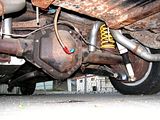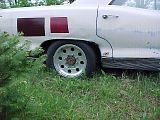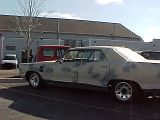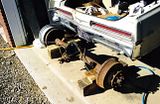I'd rather tow a house with a 4-cylinder F350 than a car with a 7.3L. Engine power and transmission capability are only a tiny part of it. Sure, you can accelerate fine, but one stiff breeze and you'll be in a ditch. Its the whole package; brakes, massive leaf springs that keep the axle centered, tire sidewalls that don't flex as much, enough weight to anchor the trailer... its a big thing.
Tow ratings are often times complete BS. A good example: a 96 Caprice with the 4.3L and the 7.5" rear axle and 2.56 gears is rated to tow more than my 96 Impala SS with a 5.7L and the 8.5" rear and 3.08 gears. That is marketing to the intended consumer. Lowering the tow rating means they can deny more warranty claims on the SS and the consumer doesn't care because market research suggests SS owners aren't buying it to tow.
Tow ratings are also BS from the standpoint of trailer factors. A 10,000 lb flatbed with a tractor on it is a lot different than a 10,000 lb travel trailer with cheap axles that catches wind like a billboard. A 30' triple axle car hauler will behave much differently than a 30' double axle enclosed trailer. Not to mention torsion axles act differently than trundle/spring axles.
Tow ratings are also BS from the standpoint of different drivers. I used my 73 Impala to tow a 9500 lb trailer a few times for short distances. The trailer had excellent brakes, I wasn't going far, and I know how to drive an automatic so that it doesn't fry itself. Contrast that with someone else who might get in their new F150, put in OD, hitch up a 9500 lb trailer and put their foot to the floor.
The manufacturer gives you tow ratings as a guideline. They are basically saying that if the tow rating is 5000 lbs and your transmission explodes while you're towing 5001 lbs, they can tell you to go to hell. They are also protecting themselves from class-action lawsuits. If 15% of their buyers experience (let's say) rear axle bearing failure while towing an 8000-lb load, its wise that manufacturers under-rate the tow capacity to prevent legal losses.
I am building a 66 Bonneville with a Duramax. It already has 3/4 ton front spindles and brakes, a 10.5" full-floater rear, and massive brakes all around. Spring rates are modest, but backed up with airbags. In a straight line, it will tow three houses uphill with an anchor dragging behind. But, right now it has a modified version of the factory 4-link trailing arms with rubber bushings. It also has the stock 4" channel frame and no room for truck tires. You can't compare that to an 8" x 4" fully boxed ladder frame like what comes under an F250 with big leaf springs and E-range 30" diameter tires.
I will be towing with my Bonny. I plan to get something like a vintage airstream or Spartan trailer and fix it up, but regardless of how heavy-duty the parts are that I bolt on, its still a 4000-lb flimsy car - not a 6000-lb box-frame truck.














































